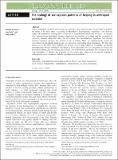Files in this item
The ecology of sex explains patterns of helping in arthropod societies
Item metadata
| dc.contributor.author | Davies, Nicholas | |
| dc.contributor.author | Ross, Laura | |
| dc.contributor.author | Gardner, Andy | |
| dc.date.accessioned | 2016-06-02T10:30:08Z | |
| dc.date.available | 2016-06-02T10:30:08Z | |
| dc.date.issued | 2016-07-11 | |
| dc.identifier.citation | Davies , N , Ross , L & Gardner , A 2016 , ' The ecology of sex explains patterns of helping in arthropod societies ' , Ecology Letters , vol. 19 , no. 8 , pp. 862-872 . https://doi.org/10.1111/ele.12621 | en |
| dc.identifier.issn | 1461-023X | |
| dc.identifier.other | PURE: 242202114 | |
| dc.identifier.other | PURE UUID: 89624f6a-b441-47d1-aa29-fb6688071ec8 | |
| dc.identifier.other | Scopus: 84971602464 | |
| dc.identifier.other | WOS: 000379966300004 | |
| dc.identifier.uri | https://hdl.handle.net/10023/8915 | |
| dc.description | Authors thank the Natural Sciences and Engineering Research Council of Canada (NGD), the Clarendon Fund (NGD) and the Natural Environment Research Council (LR, NE/K009516/1; AG, NE/K009524/1) for funding. | en |
| dc.description.abstract | Across arthropod societies, sib-rearing (e.g. nursing or nest defence) may be provided by females, by males or by both sexes. According to Hamilton's ‘haplodiploidy hypothesis’, this diversity reflects the relatedness consequences of diploid vs. haplodiploid inheritance. However, an alternative ‘preadaptation hypothesis’ instead emphasises an interplay of ecology and the co-option of ancestral, sexually dimorphic traits for sib-rearing. The preadaptation hypothesis has recently received empirical support, but remains to be formalised. Here, we mathematically model the coevolution of sex-specific helping and sex allocation, contrasting these hypotheses. We find that ploidy per se has little effect. Rather, the ecology of sex shapes patterns of helping: sex-specific preadaptation strongly influences who helps; a freely adjustable sex ratio magnifies sex biases and promotes helping; and sib-mating, promiscuity, and reproductive autonomy also modulate the sex and abundance of helpers. An empirical survey reveals that patterns of sex-specific helping in arthropod taxa are consistent with the preadaptation hypothesis. | |
| dc.format.extent | 11 | |
| dc.language.iso | eng | |
| dc.relation.ispartof | Ecology Letters | en |
| dc.rights | © 2016 The Authors. Ecology Letters published by CNRS and John Wiley & Sons Ltd. This is an open access article under the terms of the Creative Commons Attribution License, which permits use, distribution and reproduction in any medium, provided the original work is properly cited. | en |
| dc.subject | Eusociality | en |
| dc.subject | Haplodiploidy | en |
| dc.subject | Inbreeding | en |
| dc.subject | Inclusive fitness | en |
| dc.subject | Local mate competition | en |
| dc.subject | Local resource enhancement | en |
| dc.subject | Manipulation | en |
| dc.subject | Preadaptation | en |
| dc.subject | Sex ratio | en |
| dc.subject | Sib-mating | en |
| dc.subject | QH301 Biology | en |
| dc.subject | QL Zoology | en |
| dc.subject | BDC | en |
| dc.subject | R2C | en |
| dc.subject.lcc | QH301 | en |
| dc.subject.lcc | QL | en |
| dc.title | The ecology of sex explains patterns of helping in arthropod societies | en |
| dc.type | Journal article | en |
| dc.contributor.sponsor | NERC | en |
| dc.description.version | Publisher PDF | en |
| dc.contributor.institution | University of St Andrews. School of Biology | en |
| dc.contributor.institution | University of St Andrews. Centre for Biological Diversity | en |
| dc.identifier.doi | https://doi.org/10.1111/ele.12621 | |
| dc.description.status | Peer reviewed | en |
| dc.date.embargoedUntil | 2016-06-02 | |
| dc.identifier.grantnumber | NE/K009524/1 | en |
This item appears in the following Collection(s)
Items in the St Andrews Research Repository are protected by copyright, with all rights reserved, unless otherwise indicated.

